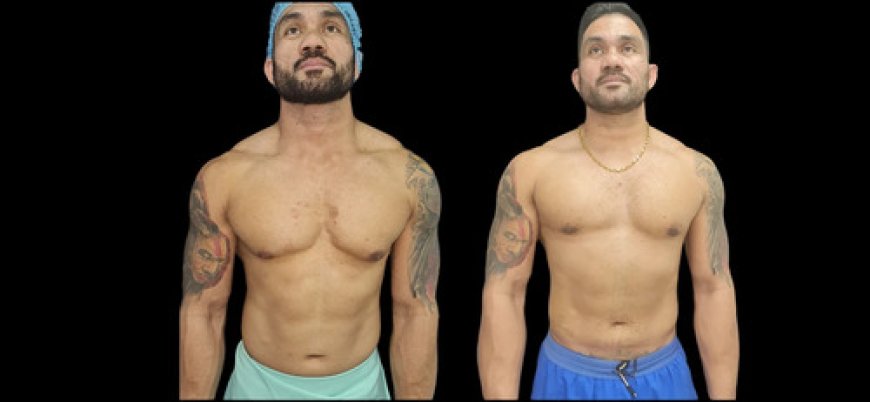Recovery from Male Breast Reduction: A Day-by-Day Guide
Follow our day-by-day guide to recovery from male breast reduction. Get tips, timelines, and advice for a smooth healing process and optimal results.

Male breast reduction surgery, also known as gynecomastia surgery, is an effective solution for men struggling with enlarged breast tissue. Understanding the recovery process is crucial for achieving the best results and ensuring a smooth healing journey. This day-by-day guide will walk you through what to expect after male breast reduction surgery, with a focus on recovery tips and insights into the best practices. For those considering male breast reduction in Dubai, this guide will also highlight the importance of selecting the best plastic surgery clinic in Dubai and showcase before and after male breast reduction photos to illustrate the transformative results.
Day 1: The Day of Surgery
Post-Surgery Recovery Room
After the surgery, you will be taken to a recovery room where medical staff will monitor you as the anesthesia wears off. You may feel groggy, disoriented, and experience some discomfort.
-
Pain Management: Pain and discomfort are common after surgery. Your surgeon will prescribe pain medications to help manage this.
-
Compression Garment: You will be fitted with a compression garment to minimize swelling and support the healing tissues.
-
Observation: Medical staff will observe you for a few hours to ensure there are no immediate complications.
Going Home
Most patients are allowed to go home the same day. Ensure you have arranged for someone to drive you home and stay with you for the first 24 hours.
Days 2-3: Immediate Postoperative Period
Rest and Recovery
The first few days post-surgery are crucial for rest and recovery. Your primary focus should be on allowing your body to heal.
-
Rest: Stay in bed or on the couch with minimal movement.
-
Hydration and Nutrition: Drink plenty of fluids and eat light, nutritious meals.
-
Wound Care: Follow your surgeon’s instructions for caring for your surgical wounds. Keep the area clean and dry.
Managing Pain and Discomfort
-
Medication: Take prescribed pain medications as directed. Do not skip doses.
-
Cold Compress: Applying a cold compress to the chest area can help reduce swelling and discomfort.
Monitoring Symptoms
-
Swelling and Bruising: Expect swelling and bruising around the chest area. This is normal and will gradually subside.
-
Fever: A slight fever is normal, but contact your surgeon if it exceeds 100.4°F (38°C) or if you experience severe pain, redness, or discharge from the incision sites.
Days 4-7: Early Recovery
Increasing Activity
Gradually start to increase your activity level.
-
Light Walking: Begin with short, gentle walks around the house to promote circulation and prevent blood clots.
-
Avoid Strenuous Activities: Do not engage in strenuous activities or heavy lifting. Follow your surgeon’s guidelines on physical restrictions.
Follow-Up Appointment
-
Surgeon Check-Up: Attend your follow-up appointment with your surgeon. They will check your healing progress, remove or replace dressings, and address any concerns.
Compression Garment
-
Wearing the Garment: Continue wearing the compression garment as instructed by your surgeon. It helps to reduce swelling and supports the chest area during healing.
Days 8-14: Ongoing Recovery
Gradual Return to Normal Activities
You can slowly start resuming normal activities, but still avoid any strenuous exercises or heavy lifting.
-
Light Activities: Light household chores are usually permitted, but avoid anything that strains the chest muscles.
-
Driving: You may be able to drive, but only if you are no longer taking strong pain medications and feel comfortable.
Monitoring Healing
-
Incision Care: Keep monitoring the incision sites for any signs of infection. Continue to keep them clean and dry.
-
Swelling and Bruising: Swelling and bruising should start to diminish. If you notice any persistent or worsening symptoms, contact your surgeon.
Weeks 3-4: Intermediate Recovery
Resuming More Activities
At this stage, you can begin to resume more of your regular activities.
-
Work: Many patients can return to work, especially if it does not involve physical labor.
-
Exercise: Light exercises such as walking can be increased, but avoid upper body workouts and strenuous activities.
Continued Monitoring
-
Healing Progress: Continue to monitor your healing progress. Swelling should be significantly reduced.
-
Follow-Up: Attend any additional follow-up appointments to ensure your recovery is on track.
Results Becoming Visible
-
Before and After Photos: Around this time, you may start to see the initial results of your surgery. Comparing before and after male breast reduction photos can be encouraging and help you visualize the improvements.
Weeks 5-6: Advanced Recovery
Full Return to Normal Activities
By this stage, most patients can return to their normal routines, including exercise, with some restrictions.
-
Exercise: Gradually reintroduce upper body exercises as advised by your surgeon.
-
Activities: Resume all daily activities, but still avoid anything that puts excessive strain on the chest.
Final Results
-
Appearance: The final results of your surgery will become more apparent. The chest will have a more natural, masculine contour.
-
Scar Care: Follow your surgeon’s recommendations for scar care to minimize their appearance.
Conclusion
Recovery from male breast reduction surgery is a gradual process that requires patience and adherence to your surgeon’s instructions. For those considering male breast reduction in Dubai, selecting the best plastic surgery clinic in Dubai is essential for achieving optimal results. Viewing before and after male breast reduction photos can provide motivation and set realistic expectations. By following this day-by-day guide, you can navigate the recovery process with confidence and look forward to enjoying the benefits of your new, contoured chest.

 MenSurgery
MenSurgery 










